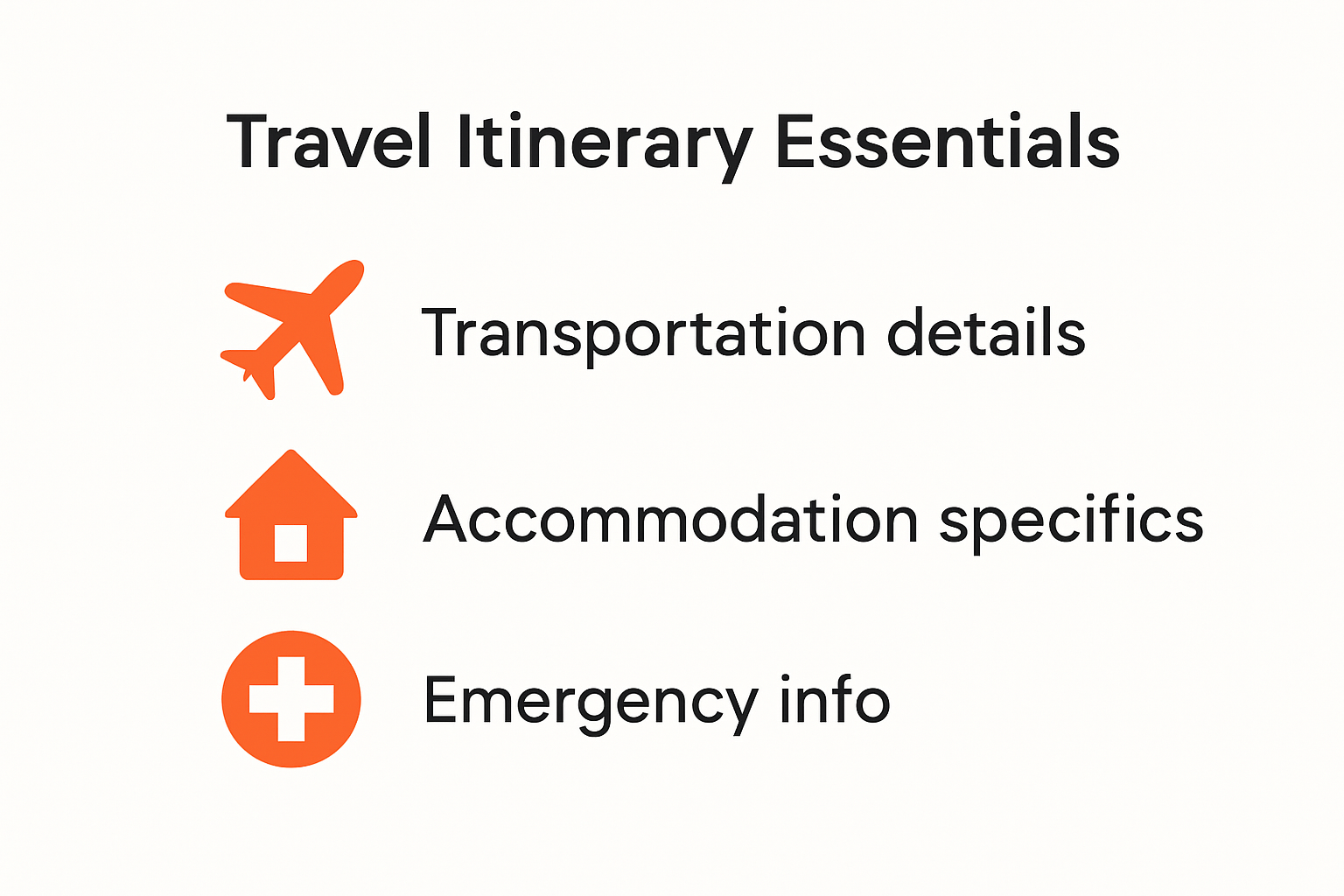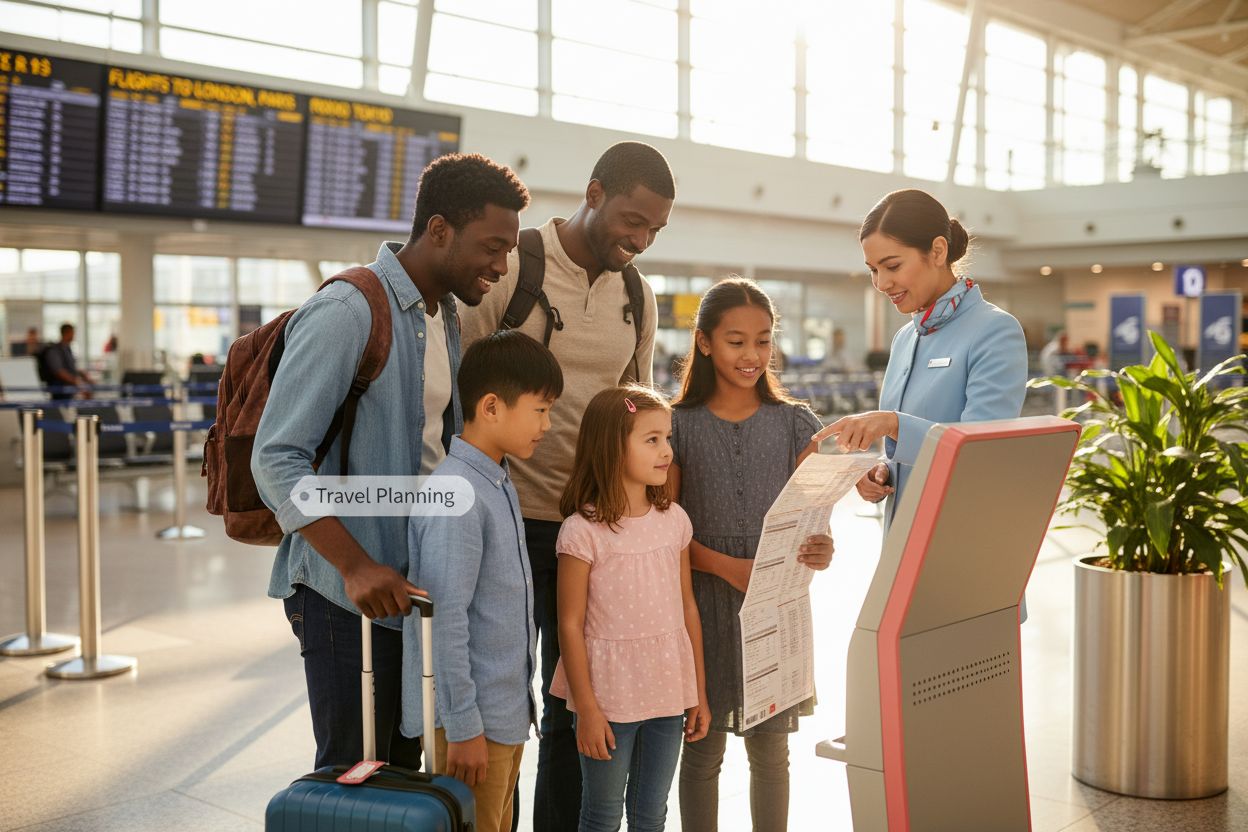Building a travel itinerary is more than just jotting down a few hotel names and flight numbers. Americans took over 1 billion trips in 2023 alone according to the U.S. Department of Commerce, and you’d think most travelers prefer to leave plenty of details open for spontaneity. Surprisingly, research shows the happiest travelers are actually the ones with the most detailed plans. Turns out, crafting a good itinerary does not limit adventure. It’s the secret ingredient that lets you explore more, worry less, and remember the best parts long after the bags are unpacked.
Table of Contents
- Defining What A Travel Itinerary Is
- Benefits Of A Travel Itinerary For U.S. Travelers
- Key Elements Every Itinerary Should Include
- How To Build The Perfect Travel Itinerary
Quick Summary
| Takeaway | Explanation |
|---|---|
| A travel itinerary is essential for planning. | A detailed travel itinerary serves as a roadmap, ensuring all trip details are organized and accessible. |
| Include key logistics and activities. | An effective itinerary includes transportation, accommodation, and planned activities to enhance travel efficiency. |
| Personalize your itinerary for unique experiences. | Tailoring your travel plan to your interests allows for more meaningful adventures and connections with destinations. |
| Prioritize safety and emergency info. | Comprehensive itineraries should include emergency contacts and essential travel documents for increased traveler safety. |
| Balance planning with flexibility. | A good itinerary allows for both structured activities and spontaneous discoveries, enhancing overall travel enjoyment. |
Defining What a Travel Itinerary Is
A travel itinerary is a comprehensive plan that outlines the detailed schedule and logistics of a trip, serving as a crucial roadmap for travelers navigating their journey. More than just a simple list of destinations, a travel itinerary provides a structured framework that captures every essential aspect of travel from departure to return.
The Essential Components of a Travel Itinerary
A well-crafted travel itinerary goes beyond basic scheduling. According to U.S. Customs and Border Protection, a thorough itinerary typically includes critical information such as specific travel dates, transportation modes, accommodation details, planned activities, and precise location information. These documents serve not just as personal planning tools but also as official records that can be required for border entry, visa applications, and travel authorization.
The most effective travel itineraries capture nuanced details that transform a generic trip into a personalized adventure. This means including not just where and when you will travel, but also incorporating specific preferences like preferred dining experiences, must-see attractions, reservation times, and potential alternative plans in case of unexpected changes.
Why Travelers Need a Detailed Itinerary
Travelers benefit immensely from a well-developed itinerary. Beyond organizational advantages, a comprehensive travel plan provides multiple practical benefits. Travel experts recommend that a good itinerary helps manage time effectively, reduces stress by eliminating last-minute uncertainties, and allows travelers to maximize their experience by ensuring they don’t miss important attractions or events.
Moreover, a detailed itinerary acts as a safety net. It provides family or emergency contacts with your precise travel schedule, includes backup contact information, and can be crucial in situations requiring rapid communication or assistance. For international travelers, this level of detail can be especially important when navigating unfamiliar destinations or dealing with potential travel disruptions.
Modern travelers have numerous tools at their disposal to create sophisticated itineraries. Digital platforms now offer dynamic, adaptable planning options that can be modified in real-time, synchronized across devices, and shared with travel companions. These advanced systems allow for unprecedented levels of customization and flexibility, transforming traditional travel planning into an interactive and collaborative experience.
Whether you’re planning a weekend getaway or a month-long international expedition, a well-constructed travel itinerary remains an indispensable tool for ensuring a smooth, enjoyable, and memorable journey. By investing time in detailed planning, travelers can transform potential travel stress into anticipation and excitement for the adventures that await.

Benefits of a Travel Itinerary for U.S. Travelers
A travel itinerary is more than a simple document tracking travel details. For U.S. travelers, it represents a strategic approach to maximizing travel experiences, minimizing potential risks, and creating memorable journeys. The advantages of a well-constructed travel plan extend far beyond basic logistics.
To help you compare the main benefits of having a well-constructed travel itinerary as highlighted for U.S. travelers, this table summarizes each advantage and its practical impact:
| Benefit | Practical Impact |
|---|---|
| Strategic Time & Resource Mgmt | Optimizes schedules, avoids overcrowding, maximizes meaningful experiences, manages budget |
| Enhanced Safety & Preparedness | Provides real-time updates, access to emergency info, enables rapid communication during unexpected situations |
| Cultural & Educational Exploration | Enables deeper engagement with historical sites, landmarks, and culture; turns trips into learning experiences |
| Stress Reduction | Minimizes uncertainties, supports structured yet flexible travel, increases peace of mind |
Strategic Time and Resource Management
According to the U.S. Department of Commerce, effective travel planning enables travelers to optimize their time and resources. By establishing clear appointments and spacing activities comfortably, travelers can avoid the stress of overcrowded schedules and enjoy more meaningful interactions at each destination. This approach transforms travel from a hectic series of rushed moments into a thoughtful, intentional experience.
Travelers who invest time in detailed planning often discover unexpected efficiencies. Mapping out transportation routes, understanding local transit systems, and pre-booking key attractions can significantly reduce travel time and unexpected expenses. This strategic approach allows travelers to allocate their budget more effectively and create room for spontaneous experiences that truly enhance their journey.
Enhanced Safety and Preparedness
Research from the University of California, Riverside highlights the critical safety benefits of comprehensive travel planning. By registering travel itineraries with intelligent tracking services, travelers gain access to real-time intelligence about potential risks such as political unrest, natural disasters, or health warnings. This proactive approach transforms travel preparation from a passive activity to an active risk management strategy.
A detailed itinerary also serves as a vital communication tool. It provides emergency contacts with precise information about your whereabouts, travel routes, and scheduled destinations. In situations requiring rapid assistance or communication, this document can be instrumental in ensuring traveler safety and facilitating quick responses to unexpected situations.
Cultural and Educational Exploration
Travel itineraries are not just logistical tools but gateways to deeper cultural understanding. The National Park Service’s Travel Itinerary Series demonstrates how structured travel plans can transform journeys into educational experiences. By intentionally incorporating historical sites, cultural landmarks, and diverse experiences, travelers can create rich, meaningful narratives around their trips.
For U.S. travelers, a well-crafted itinerary can turn a simple vacation into an immersive learning experience. Whether exploring national parks, historical monuments, or local cultural centers, strategic planning allows travelers to engage more deeply with their destinations. Learn more about optimizing your travel planning to create journeys that are not just trips, but transformative experiences.
Ultimately, a travel itinerary is a powerful tool that empowers U.S. travelers to take control of their journeys. By combining careful planning with flexibility, travelers can create experiences that are both structured and spontaneous, safe and adventurous, practical and profoundly memorable.
Key Elements Every Itinerary Should Include
Creating a comprehensive travel itinerary requires careful attention to multiple critical components that transform a basic travel plan into a robust, actionable guide. While each journey is unique, certain fundamental elements are essential for ensuring a smooth and well-organized travel experience.
To help you remember the crucial elements every travel itinerary should cover, here’s a summary table of the key components identified in the article and what each should include:
| Element | What to Include |
|---|---|
| Transportation Details | Flight/train/bus info, departure & arrival times, routes |
| Accommodation Details | Hotel/lodging name, address, contact number, reservation code, check-in/out times |
| Planned Activities | Specific attractions, tours, restaurant reservations, entertainment, with estimated durations |
| Emergency Information | Copies of passport, insurance docs, emergency contacts, local embassy info, medical details |
| Backup Plans | Alternative accommodations, communication methods, flexible activity time |
| Communication Details | International phone/data options, messaging apps, backup strategies |

Fundamental Travel Logistics
According to the Wikipedia entry on travel itineraries, a successful itinerary must capture precise travel-related details that provide a clear roadmap for the entire journey. This includes comprehensive transportation information such as flight numbers, departure and arrival times, train or bus schedules, and specific transportation routes between destinations.
Accommodation details represent another crucial element. Each entry should include complete hotel or lodging information, including full addresses, contact numbers, reservation confirmation codes, and check-in and check-out times. Travelers should also note alternative accommodation options or backup plans in case of unexpected changes.
Comprehensive Activity and Experience Planning
Drawing insights from NIOS tourism curriculum, effective itineraries go beyond basic logistics by incorporating a strategic mix of planned activities and flexible exploration time. This means detailing specific attractions, museum visits, guided tours, restaurant reservations, and entertainment options while simultaneously leaving room for spontaneous discoveries.
Smart travelers understand the importance of balancing structured experiences with unscheduled moments. Your itinerary should include estimated durations for each activity, proximity between locations, and potential time buffers to prevent overscheduling. This approach ensures a more relaxed and enjoyable travel experience that doesn’t feel rushed or overwhelming.
Essential Emergency and Support Information
A truly comprehensive itinerary includes critical emergency and support documentation that can prove invaluable during unexpected situations. This section should encompass multiple layers of protective information, including copies of passport details, travel insurance documents, emergency contact numbers, and local embassy information.
Read our comprehensive guide on travel preparation to understand how to develop a robust support network during your travels. Include digital and physical copies of important documents, medications list, allergies, and any specific health considerations that might impact your journey.
Additionally, travelers should document alternative communication methods, including international phone plans, messaging apps, and backup communication strategies. Having multiple communication channels ensures you remain connected and can quickly address any travel disruptions.
Ultimately, a well-constructed travel itinerary serves as more than a simple schedule. It becomes a personalized travel companion that combines practical planning with the excitement of exploration, providing travelers with the confidence to navigate new experiences while maintaining a sense of security and preparedness.
How to Build the Perfect Travel Itinerary
Building the perfect travel itinerary is an art form that combines meticulous planning with creative flexibility. For U.S. travelers seeking to transform their trips from ordinary to extraordinary, a strategic approach to itinerary development can make all the difference in creating memorable experiences.
Initial Planning and Research
According to the U.S. Department of Commerce, effective travel planning begins with thoughtful research and realistic scheduling. They recommend limiting daily activities to two or three confirmed appointments, strategically spaced to prevent exhaustion and allow for genuine exploration. This approach means understanding your destination’s unique rhythm and planning activities that complement local culture and travel dynamics.
The research phase involves deep investigation into your destination. This includes studying local transportation systems, understanding cultural norms, checking seasonal variations, and identifying must-see attractions. Utilize multiple resources such as travel blogs, official tourism websites, traveler forums, and recommendations from experienced visitors to gather comprehensive insights.
Budget and Logistical Considerations
AAA recommends a systematic approach to travel budgeting, emphasizing the importance of financial planning before finalizing your itinerary. Start by estimating costs for critical elements like transportation, accommodation, meals, and activities. Consider exploring multiple travel dates, comparing midweek versus weekend prices, and investigating vacation packages that might offer better overall value.
Technological tools can significantly streamline this process. Many travel platforms now offer price comparison features, allowing travelers to optimize their budgets efficiently. Look for opportunities to save, such as booking during off-peak seasons, using loyalty programs, or bundling services. Remember that a well-planned budget provides not just financial control but also peace of mind during your journey.
Personalization and Flexibility
The Good Tourism Institute emphasizes the critical importance of personalization in modern travel planning. Your itinerary should reflect your unique interests, travel style, and personal preferences. This means incorporating optional experiences, diverse transportation choices, and accommodations that resonate with your travel goals.
Discover advanced travel planning strategies that can help you create a truly customized experience. Consider building in buffer time for unexpected discoveries, spontaneous experiences, or potential travel disruptions. While structure is important, the most memorable travel moments often emerge from unplanned interactions and serendipitous encounters.
A perfect travel itinerary is not about filling every moment with activity but creating a balanced framework that allows for structured exploration and organic discovery. It should feel like a supportive guide rather than a restrictive schedule, empowering travelers to embrace the journey’s inherent unpredictability while providing a sense of security and direction.
Ultimately, the art of crafting the perfect itinerary lies in striking a delicate balance between meticulous planning and spontaneous adventure. By combining thorough research, strategic budgeting, and a personalized approach, travelers can transform their trips from simple vacations into truly transformative experiences.
Frequently Asked Questions
What is a travel itinerary?
A travel itinerary is a detailed plan that outlines the schedule and logistics for a trip, including transportation, accommodations, activities, and important travel information.
Why do I need a detailed travel itinerary?
A detailed travel itinerary helps manage time effectively, reduces stress by eliminating uncertainties, ensures you don’t miss important attractions, and provides vital information for safety and emergency situations.
What key elements should be included in a travel itinerary?
Essential elements of a travel itinerary include transportation details, accommodation information, planned activities, emergency contacts, and backup plans for unexpected situations.
How can I personalize my travel itinerary?
You can personalize your travel itinerary by including activities that reflect your interests, adding unique dining experiences, and allowing for flexible time slots for spontaneous exploration.
Tired of Travel Planning Stress? Experience Itinerary Simplicity with Yopki
Planning your perfect trip should not mean endless spreadsheets, confusing logistics, or missed opportunities. As explained in our guide, even the best travelers struggle with organizing transportation details, managing last-minute changes, and keeping every confirmation in order. A detailed travel itinerary is essential, but many find themselves sacrificing time, flexibility, or peace of mind just trying to keep it all together.

Let Yopki take the stress out of your travel planning. In just minutes, you can automatically create a personalized itinerary that fits your interests and travel style. Use our smart map to minimize wasted time and instantly update your plans with a swipe. Everything is in one place—including flights, reservations, and experiences—for safe, easy access on the go. Ready to build an itinerary that captures the best of your destination with fewer worries? Start your journey now at Yopki’s travel app and see how effortless planning can be. Don’t let confusion or chaos hold you back from your next adventure. Try Yopki and focus on the moments that matter most.



